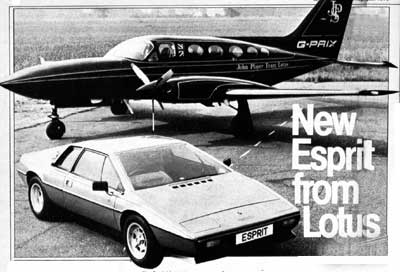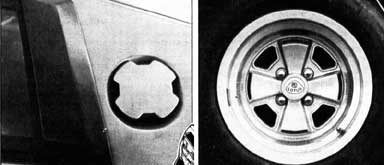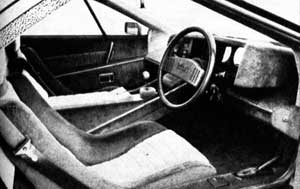

Lotus Esprit S2
Revisions for Lotus's
slinky mid-engined two-seater best-seller
AutoCar August 1978
Since its announcement in October 1975 and its production life which began nearly a year later, you could be forgiven for thinking that the Lotus Esprit has not been a conspicuous success. You still don't see many about, certainly not by the standards of a better-established rival like Porsche. But in fact Lotus say that a total of 1,300 Esprits have been sold, and three-quarters of them have been exported, notably to the States – 12 million dollars worth. This week some interesting revisions are announced, the new car being called the Lotus Esprit S2.
There are no major changes. The basic layout stays the same – Lotus's 2-litre 160bhp light-alloy four sits longitudinally behind the driver, mated to the Maserati five-speed transaxle originally made for the now-dead Citroen SM. Coil-spring suspension is partly borrowed from the Opel Ascona in front – double wishbones with an integral anti-roll bar – and Lotus's own Elite-based three-link independent arrangement at the back, using the drive shaft as one member. The body uses Lotus's remarkable low pressure injection moulding method (details of which Lotus still try to keep from competitors) to form two glass-fibre sections, upper and lower, like a plastic model car; the necessary join at waist level is made a feature of the Ital Design styling.
So what has changed? From outside the greatest difference is in the way the front spoiler has been wrapped around at the sides to improve straight-line stability and aerodynamic balance, and to put more air through the new larger-capacity radiator. The other important aerodynamic move which will incidentally aid recognition is the fitting of quite pronounced air scoops between the rear quarter window and the fuel filler cap on each side. Happily, as you would expect from such a functional design team as Lotus, these are not dummies and they have important jobs to perform. The left-hand one feeds ram-induced air via a spreader duct placed close to the back window into the rear luggage compartment, 'ensuring', say Lotus, 'a constant flow of air over the inside of the rear screen, preventing condensation build-up in high humidity climates.' You will of course only persuade air through a closed box like a boot if it has got somewhere to get out afterwards. This is provided by a corresponding duct on the other side of the glass which collects the air into a tube duct leading into the side of the carburettor air-filter box. Even at idle, therefore, the luggage compartment air is on the move. The air scoop on the right feeds cooling air directly into the engine compartment itself.
The makers claim a useful improvement in volumetric efficiency – due one suspects as much to the coolness of incoming air as to any ram pressure effects – to the tune of 0.3 sec off the claimed 0-60 time (from 7.1 to 6.8 sec) and 0.8 sec off their 0-100 (from 20.2 to 19.4 sec).


The wheels are new, designed and styled by Lotus and made by Speedline who also produce the wheels for the World Championship-leading Lotus 79 formula 1 cars. These use the same tyres as before (205/60HR14in. front, 205/70HR14 rear) but combined with increased offset their extra widths – 7in. front, 7.5in. rear – add 1in. to the track dimensions. The bigger width is also the main reason for the adoption of a smaller 'get-you-home' 185/70VR13in. tyre and wheel as a spare.
The exhaust system is revised with an extra intermediate silencer, hot-aluminium sprayed down-pipes, aluminised main silencer and tail pipes, and olive-type pipe connections for more reliable sealing. Under the tail, the engine cover now incorporates an inspection hatch so that you don't have to take it off to check oil and water levels. It carries a new tool kit (formerly in the nose) and inside it has a hot air 'dam' separating hot (exhaust) and cold (carburettor) sides of the engine for better engine cooling and hot starting on very warm days.
Remaining exterior details include the new tail lamps with rear fog warning lamps, a different number plate panel and a black chip-resistant band on sills, spoiler and tail valance, plus double coachlines and Esprit S2 transfers on the rear gussets – which unfortunately continue, blocking rear quarter view.
Inside, the instrument cluster has been altered to make it easier to read, a revised warning lamp set-up deals with most mechanical functions including a cooling fan failure warning, rocker switches are replaced by slide ones, fibre-optic lighting is provided for switch functions (au Jaguar), and electric window switches now live closer to the gear lever. A digital clock, its display dimmed when the side lamps are on, sits between the sun visors. Seats are 2in. wider, claimed to give better lateral and lumbar support and allow 1in. more headroom.
Price increases by slightly more than 9 per cent. Lotus say that the first two Esprit S2 examples have been delivered to Mario Andretti and Ronnie Peterson. Ordinary mortals should be able to find one from announcement day (16 August) if they are quick off the mark. Total Hethel production now (of Elites, Eclats and the new Esprits) averages around 30 a week; Esprits are Lotus's best seller and up to 20 are produced per month. At present, with a buoyant Lotus home market, roughly half of these are sold in Britain.
Lotus Esprit S2 prices
Basic £9,508.00
Special Car Tax £792.34
Total (in GB) £11,124.37Extras (inc. VAT)
Leather trim £236.34
Radio £76.05
Metallic paint £140.40
|
|